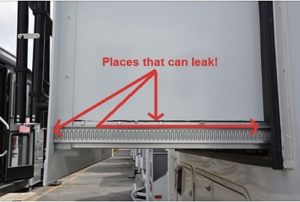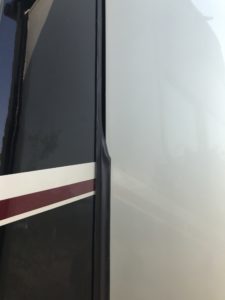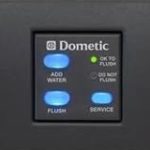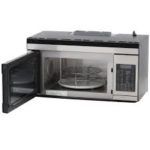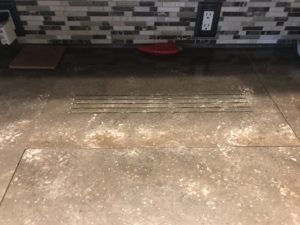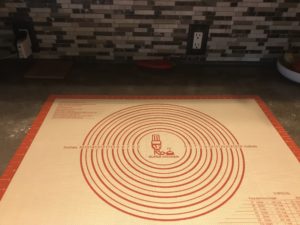I want to start by giving you just a brief bit of background as to my RV buying experience.
First off, you should know that one of my semi retirement jobs was selling new and used cars for a Chevrolet Dealership for almost 2 years. I was a really good salesman and was given the GM Award of Excellence. In addition to this great experience, I have pretty much been a sales person most of my adult life, after my experiences in social work and teaching. The only reason I am telling you this, is to give you confidence that I understand the buying process from both sides.
I have also bought and sold many RVs over the years. In the “About Us” section, I detail the 8 different trailers and motorhomes that I have owned over the past 18+ years. I have only traded RVs once, the rest of the time I sold the old RVs myself, usually using Craig’s List.
The discussion below is going to sound a bit negative, I am afraid. But my goal here is to be very honest in my cautions to improve the chances that you will have few if any regrets, months after you make your purchase. You will have lots of time after you buy your new RV to enjoy the incredible, positive RV experience!
To make things much clearer, i am going to list the tips I want to give you. I am going to group them under buying a new RV and buying a used one:
Buying a New RV
1.Do your homework!
I can’t tell you how much of an advantage the sales person has over you if you arrive at a dealership with very little knowledge of the market place.
a. TYPE – Start with knowing the type of RV you want. bumper pull trailer, fifth wheel trailer or class A, B or C motorhome. Use the “Choosing Your RV” article in our BLOG to help you decide.
b. LAYOUT – Decide on a layout, if you can. Choosing a layout is critical in the beginning and there are lots of things to consider when choosing the best layout for your living situation. These are all detailed in the “Choosing Your RV” section. Layout is not something that you can change later so you need make sure that you understand what you need to live comfortably. In the process, also consider the length of the RV.
c. BRANDS – After you have decided on the type and layout of the RV you need to decide on a couple of brands that you want to consider. Obviously in considering these brands, you have determined that each offers the layout that you want. There are lots of brands of brands to consider and just as many opinion as to which is best. After doing lots of research, talking with people who have them, and drawing on my own experiences, the following are my recommendations:
Travel Trailers – The Best – Airstream, Casita and Oliver
Avoid – any Thor , Gultstream or Coachman products
Fifth Wheels – The Best – Mobile Suites and Van Leigh(Tiffin)
Avoid – any Thor, Gulfstream or Coachman products
Motorhomes – The Best – Prevost, Tiffin, Newell, and Newmar
Avoid – any Thor, Fleetwood, Gulfstream or Coachman Product
Obviously, i have left out a huge number of brands that are somewhere in the middle between the Best and the Worst. I would research those brands carefully and then decide.
2. Go to an RV Show
This is a great way to see a lot of options in one place and at one time. There will be lots of layouts and brands and it will give you an opportunity to further refine your search.
a. Decide before you go whether you are “researching” and NOT buying or “shopping”, meaning you have done your research and know what you want. This means that you understand the actual costs of the brands and layout you want and can actually buy with knowledge.
b. Sometimes you can find a some great deals both for the RV and in financing at RV shows.
c. If you have lots of time, visit the factory where your potential new home is built. Get an idea of how it is put together and the level of care that is taken in construction.
3. Go to a Dealership
Going to a dealership to buy an RV is not like buying a car. An RV is incredibly more complicated by its very nature and often times much more expensive. It some ways it is like buying a car and a house at the same time.
a. A sales person is there to make money, and the only way he or she can do so, is to sell you something.
b. The sales person is not your friend. It is great to establish a nice cordial relationship with a sales person, but just remember fostering a trusting relationship is their first objective and is part of the selling process.
c. Getting your trust is key for then in selling you an RV. This is the entire reason why you must go to a dealership prepared, knowledgeable and determined.
d. Ask lots of questions. You should be sure before you go that if you are purchasing a trailer or fifth wheel, that your vehicle is up to it. You should have researched the weight of the RVs you are looking at in your final list and be sure that your vehicle can tow them.
e. Find out in advance what the delivery process and follow up after the sale is like. You deserve a delivery process that leaves you feeling like you understand your new purchase and generally how to operate everything.
4. Negotiate
Knowing generally the cost of what your new RV is selling for in the market place is key here.
a. You should generally get between 25% and 30% off the MSRP (manufacture’s suggested retail price) of a new RV. Do not fall for phrases like “RVs like this are hard to find”, “this RV will not last” “the market place for RVs is particularly hot right now”.
b. If you find the sales person difficult to deal with, too pushy and unable to answer your questions knowledgeably, then leave. There are usually lots of dealerships available. You can also request another sales person.
5.Deposits/Test Drives/Inspections
Thoughts:
a. You should never have to put down a deposit to take a test drive in a motorhome. That is ridiculous. To me it is insulting and suggests that the dealership does not believe you are a serious buyer. My suggestion is to walk away.
b. Negotiating such things as trailer hitches, sway bars and fifth wheel hitches should be brought up when you are beginning to narrow you decision and before you make any deposit.
c. $500 to $1000 is more than adequate of a deposit to give a dealership to hold the RV until you get financing, if that is required. Because our last purchase of our Tiffin was 600 miles away, we gave the dealership $500 refundable deposit to hold it until we could get there to view it and take a test drive. We had secured the financing, insurance and everything else in advance of going to see it.
d. Inspect, inspect, inspect. Never assume even a new RV is in complete working order. Allow an entire day for the buying process, beginning early. Take a printed list with you of things to check, plumbing, electricity, heaters, AC etc. It is always a great idea to take an impartial friend with you that you can turn to for advice. This should be someone who will not get caught up in the emotions of the purchase experience.
e. Get it in writing – If anything is not working, make sure you get agreement that it will be made right, in writing with a specific time frame when it will be completed. I have heard many horror stories of issues with RVs, even new RVs that dealers refused to fix or that took months to resolve.
f. Get it in writing – If the issues are extensive, or major, do not accept the RV, do not sign, do not pay any money until the issues are solved. This is very hard to do sometimes when your new baby is sitting there, begging for you to take her home. Remember when the dealer has your money, and you have signed, the RV is yours. Your chance to get issues resolved at this point just rests on the good will of the dealership. Remember my comment earlier about the sales person not being your friend?
6. Extended Warranties
I know the arguments for and against buying and extended warranty and for a used RV, I am for it. We purchased one when we bought our 2005 Tiffin Phaeton motorhome 2 years ago. Like the purchase price of the motorhome, however, we negotiated even threatened to buy it else where. We financed it in. Some thoughts:
a. If you are a bit financially stretched buying your new home, like we were, you might not have the extra cash to pay for any issues that might come up. Trust me they will in even in a pristine used motorhome and a new one.
b. An extended warranty can give you enormous peace of mind. RVs can be very complex and remember they are rolling earthquakes, so things do break.
c. I would not buy one on a new RV that already has a warranty that comes with it. Wait until the new warranty is up then consider purchasing and extended one.
d. Warranties are a huge money maker for the dealership and sales person, so again, negotiate.
e. Read the fine print. Like anything else, there are good and bad warranties. All of them generally make you go through some hoops to collect. As an aside, I have heard nothing but horror stories about Good Sam warranties.
f. Putting the money you would pay for a warranty into a savings account for repairs is a pipe dream for most people, but if you can do it, more power to you.
g. Finally in my opinion you should NEVER buy separate warranties on the paint or inside fabrics. These are a total waste of money, and are simply gravy on top of the sale for the sales person and dealership. I speak from experience. Trust me they are worthless.
7. Delivery
RV Dealerships are notoriously bad at deliveries of used and new RVs. I have talked to many people who leave with their very expensive new home and haven’t a clue as to how to operate it.
a. Insist on a thorough delivery process wherein a knowledgeable person walks you though all the systems in the RV and explains how everything works. Thoroughly understanding the delivery process is something that is good to find out right up front, as soon as you arrive at the dealership.
b. Plan on a “shake down cruise” if you will, near by, preferably near the dealership. On this initial short trip, go to an RV park in the area and set up your new home and stay over at least one night. Make plans in advance that you will be calling the dealership for information as things come up in this initial trip. It is a good idea not to do this “shake down cruise” on the weekend so that dealership personnel will be available.
Buying a Used RV
All of the considerations and cautions given above in buying a new RV from a dealership apply equally to buying a used RV. There are some additional things to consider, however.
a. Before you purchase any used RV, you should have it inspected by an unbiased person incredibly experienced in RVs and that you are paying. If you are purchasing a motorhome, you should have the engine also inspect by a licensed mechanic.(a diesel mechanic if you are purchasing a diesel powered motorhome). A couple of tips:
b. Employing a professional, licensed NRVIA (National Recreational Vehicle Inspectors Association) person is an excellent idea.
c. Do not take the dealer up on the offer of providing you with an inspector. This is obviously a conflict of interest.
d. If a dealer refuses to allow an independent inspector on the premises, then offer to take the vehicle off the premises. If they still refuse to allow the vehicle to be inspected by your inspector, find another dealer.
e. Chances are almost 100% that your inspector will find that your used potential purchase is not perfect and that there are some issues. But the key is that you now know them before you have paid for the RV. Sometimes, if you still want the RV you can negotiate the price down, or the dealership will pay to fix them. Refer to the “get it in writing”section above. It is also very possible that the inspector will miss some things but a good inspector will not miss anything major.
f. Make sure you follow the inspector around the RV. Take the time to ask questions as you go. This is an excellent opportunity to learn how your new-to-you-RV works. A good inspector will make recommendations on how to repair issues, the cost of repairs and even recommendations of resources.
g. Buying a used RV from a private party is not a lot different from all of the above with a few additional cautions:
1. If you are buying a used RV from a private party long distance, never send money to hold the RV.
2. Request lots of pictures of the exterior and interior and inspect them carefully before you take the trip. Private sellers often over sell the condition of their RVs.
3. Hiring an inspector is even more important in buying an RV from a private party. With a dealership, if things go really wrong, you have a company that you could sue or fight with bad publicity. With a private party, you have no real recourse if you failed to see issues before the purchase.
4. Financing will be more challenging buying a used RV from a private party. Make sure you understand if there are loans on the RV that need to be paid off and how that will work.

